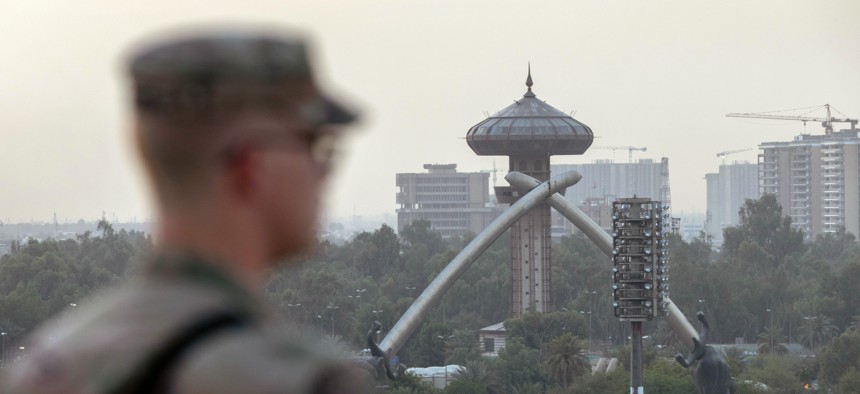
A U.S. Army soldier looks onto Baghdad and the Saddam-era Crossed Sabers monument from the International Zone on May 30, 2021. John Moore/Getty Images
Officials Deny American Troops Are Pulling Out Of Iraq as Strategic Talks Near
Biden will likely discuss the future of the American troop presence in Iraq when the prime minister visits Washington this month.
Officials shot down a report out of Baghdad on Thursday that the United States is preparing to withdraw its approximately 2,500 troops from Iraq.
The push back follows a tweet from a BBC reporter saying that Brett McGurk, the National Security Council’s top official for the Middle East and North Africa, told Iraqi officials that American troops would leave the country.
“This report is totally false,” a senior Biden administration official told Defense One. The BBC reporter later deleted her original tweet and said in a new post that U.S. officials said it was “not true,” denying the information she received from Iraqi sources.
McGurk met with Iraqi Prime Minister Mustafa Al-Kadhimi on Thursday to discuss preparations for the next strategic talks between the United States and Iraq, which first happened in April, as well as “the mechanisms for the withdrawal of combat forces from Iraq and the transition to a new phase of strategic cooperation,” according to a translation of a tweet from Al-Kadhimi’s office.
Al-Kadhimi is expected to meet with Biden in Washington later this month.
But pressure to have U.S. troops depart has been building for years, as Iranian influence in Iraq grows, and Iraq faces the consequences of proxy warfare between Iranian-backed militias and the U.S., experts said.
“Remember, the timeline for eventual withdrawal has been the subject of the bilateral strategic dialogue that Iraqis insisted on initiating in the aftermath of the Soleimani strike last year,” Scott Anderson, a former top legal advisor for the U.S. Embassy in Baghdad, tweeted about the Jan. 2020 U.S. drone strike that killed Iranian Quds Force commander Gen. Qassim Soleimani.
U.S. combat operations in Iraq ceased in 2010, and almost all U.S. troops departed Iraq by late 2011, only to return in 2014 to fight the Islamic State. Troop numbers swelled to at least 5,200 through 2018 as U.S. forces rapidly re-trained and re-equipped Iraqi units to fight ISIS.
The Pentagon ceased public reporting of troop levels in Iraq in early 2018.
Since then the Pentagon has said it has only about 2,500 troops remaining in country, primarily at the Iraqi air base in Erbil, which the U.S. uses to support its operations in Syria; at Al Asad Air Base, which has been a major training facility and the target of ballistic missile and rocket attacks by Iran and Iranian-backed militias, and at Baghdad International Airport.
When previously asked by reporters why U.S. troops were still in Iraq after the defeat of ISIS, Pentagon leadership has said that the presence is needed to keep ISIS from reconstituting itself.
Last month, the Biden administration conducted another airstrike targeting facilities of Iranian-backed militias Kata'ib Hezbollah and Kata'ib Sayyid al-Shuhada inside Iraq near the Syria-Iraq border, which Al-Kadhimi condemned as a “blatant and unacceptable violation of Iraqi sovereignty.”
Kevin Baron contributed to this report.



